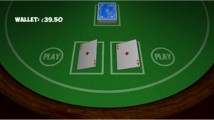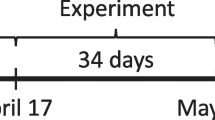Abstract
Breaks in play represent a responsible gambling strategy designed to disrupt states of dissociation and enhance the likelihood of drawing attention to a player’s session behaviour and expenditure with respect to time and money. The aim of the break in play is to motivate the player to modify or cease gambling so the activity remains within affordable levels. The aim of this study was to investigate whether imposed breaks in play in the absence of accompanying warning messages were effective in reducing cravings. Participants (141 university students) were randomly allocated to one of three conditions: 15 min computer simulated Black Jack play followed by no break, a 3 or 8 min break in play. Participants were administered a battery of measures to assess problem gambling card play, cravings, and dissociation to assess the effects of length of break on cravings. Results indicated that cravings increased rather than decreased with imposed breaks in play, and that the strength of cravings were higher following the eight- compared to 3-min break. It was concluded that breaks in play in isolation might produce counterproductive, unintended, and even perverse effects. The policy implications for responsible gambling strategies is that breaks in play ought to be accompanied with warning and/or personal appraisal messages if optimal effects in reducing within session gambling expenditure are to be achieved.


Similar content being viewed by others
References
American Psychiatric Association. (2013). Diagnostic and statistical manual of mental disorders (5th ed.). Washington, DC: American Psychiatric Association.
Anderson, G., & Brown, R. I. F. (1984). Real and laboratory gambling, sensation-seeking and arousal. British Journal of Psychology, 75, 401–410.
Andrade, E. B., Claro, D. P., & Islam, G. (2013). Misestimating betting behavior: The role of negative asymmetries in emotional self prediction. Journal of Gambling Studies, 30, 1–20.
Baron, R. M., & Kenny, D. A. (1986). The moderator-mediator variable distinction in social psychological research: Conceptual, strategic, and statistical considerations. Journal of Personality and Social Psychology, 51(6), 1173–1182.
Blaszczynski, A., Ladouceur, R., & Moodie, C. (2008a). The Sydney Laval universities gambling screen: Preliminary data. Addiction Theory and Research, 16(4), 401–411.
Blaszczynski, A., McConaghy, N., & Frankova, A. (1990). Boredom-proneness in pathological gambling. Psychological Reports, 67, 35–42.
Blaszczynski, A., Parke, J., & Parke, A. (2014). Operator-based approaches to harm minimisation in gambling. London: Responsible Gambling Trust.
Blaszczynski, A., Sharpe, L., & Walker, M. (2001). The assessment of the impact of the reconfiguration of electronic gambling machines as harm minimisation strategies for problem gambling. Sydney: University of Sydney, The University of Sydney Gambling Research Unit.
Blaszczynski, A., Walker, M., Sharpe, L., & Nower, N. (2008b). Withdrawal and tolerance phenomenon in problem gambling. International Gambling Studies, 8(2), 179–192.
Cox, B. J., Yu, N., Afifi, T. O., & Ladouceur, R. (2005). A national survey of gambling problems in Canada. Canadian Journal of Psychiatry, 50, 213–217.
Diskin, K. M., & Hodgins, D. C. (1999). Narrowing of attention and dissociation in pathological video lottery gamblers. Journal of Gambling Studies, 15(1), 17–28.
Diskin, K. M., & Hodgins, D. C. (2003). Psychophysiological and subjective arousal during gambling in pathological and non-pathological video lottery gamblers. International Gambling Studies, 3(1), 37–51.
Dockterman, E. (2013). Candy Crush saga: The science behind our addiction. Time magazine, 15 November.
Duquette, K. B. (1999). Casino employee gambling behaviour. Unpublished Masters Thesis, Las Vegas: University of Nevada.
Fong, T. W., Campos, M. D., Brecht, M., Davis, A., Marco, A., Pecanha, V., & Rosenthal, R. (2011). Problem and pathological gambling in a sample of casino patrons. Journal of Gambling Studies, 27(1), 35–47.
Gainsbury, S., Russell, A., & Blaszczynski, A. (2014). Are psychology university student gamblers representative of general student and adult gamblers? A comparative analysis. Journal of Gambling Studies, 30, 11–25.
Gupta, R., & Derevensky, J. L. (1998). An empirical examinination of Jacobs’ General Theory of Addictions: Do adolescent gamblers fit the theory? Journal of Gambling Studies, 14(1), 17–49. doi:10.1023/A:1023046509031.
Hussain, Z., & Griffiths, M. D. (2009). The attitudes, feelings, and experience of online gamers: A qualitative analysis. CyberPsychology and Behavior, 12(6), 747–753.
Jacobs, D. F. (1986). A general theory of addictions: A new theoretical model. Journal of Gambling Behavior, 2, 15–31.
Jacobs, D. (1988). Evidence for a common dissociative-like reaction among addicts. Journal of Gambling Behavior, 4, 27–37.
Jardin, B. F., & Wulfert, E. (2012). The use of messages in altering risky gambling behavior in experienced gamblers. Psychology of Addictive Behaviors, 26(1), 166–170.
Kardefelt-Winther, D. (2014). Problematizing excessive online gaming and its psychological predictors. Computers in Human Behavior, 31, 118–122.
King, D. L., Delfabbro, P. H., & Zajac, I. T. (2011). Preliminary validation of a new clinical tool for identifying problem video game playing. International Journal of Mental Health and Addiction, 9(1), 72–87.
Kirby, A., Jones, C., & Copello, A. (2014). The impact of massively multiplayer online role playing games (MMPRPGs) on psychological wellbeing and the role of play motivations and problematic use. International Journal of Mental Health and Addiction, 12(1), 36–51.
Ladouceur, R., & Sevigny, S. (2003). Interactive messages on video lottery terminals and persistence at gambling. Gambling Research, 15, 45–50.
McConaghy, N. (1980). Behavioral completion mechanisms rather than primary drive maintain behavioral patterns. Activitas Nervosa Superior (Praha), 22, 138–151.
Monaghan, S. (2008). Review of pop-up messages on electronic gaming machines as a proposed responsible gambling strategy. International Journal of Mental Health and Addiction, 6, 214–222.
Monaghan, S., & Blaszczynski, A. (2009). Impact of mode of display and message content of responsible gambling signs for electronic gaming machines in regular gamblers. Journal of Gambling Studies,. doi:10.1007/s10899-009-9150-z.
Monaghan, S., & Blaszczynski, A. (2010a). Electronic gaming machine warning messages: Information versus self-evaluation. Journal of Psychology, 144(1), 83–96.
Monaghan, S., & Blaszczynski, A. (2010b). Impact of mode of display and message content of responsible gambling signs for electronic gaming machines on regular gamblers. Journal of Gambling Studies, 26(1), 67–88.
Preacher, K. J., & Hayes, A. F. (2008). Asymptotic and resampling strategies for assessing and comparing indirect effects in multiple mediator models. Behavior Research Methods, 40(3), 879–891.
Productivity Commission. (2010). Gambling (Report no. 50). Canberra: Commonwealth of Australia. http://www.pc.gov.au/__data/assets/pdf_file/0010/95680/
Rosenthal, R., & Lesieur, H. (1993). Self-reported withdrawal symptoms and pathological gambling. In W. Eadington & J. Cornelius (Eds.), Gambling behaviour and problem gambling (pp. 337–346). Reno, NV: Institute for the Study of Gambling and Commercial Gambling.
Schellinck, T., & Schrans, T. (2002). Atlantic Lottery Corporation video lottery responsible gaming feature research: Final report. Halifax: Focal Research.
Schull, N. D. (2012). Addiction by design. Oxford: Princeton University Press.
Sokolov, E. N. (1963). Higher nervous functions: The orienting reflex. Annual Review of Physiology, 25, 545–580.
Stewart, M. J., & Wohl, M. J. A. (2012). Pop-up messages, dissociation, and craving: How monetary limit reminders facilitate adherence in a session of slot machine gambling. Psychology of Addictive Behaviors,. doi:10.1037/a0029882.
Stucki, S., & Rihs-Middel, M. (2007). Prevalence of adult problem and pathological gambling between 2000 and 2005: An update. Journal of Gambling Studies, 23, 245–257.
Tiffany, S. T. (1990). A cognitive model of drug urges and drug-use behavior: Role of automatic and non-automatic processes. Psychological Review, 97(2), 147–168.
Wardle, H., Moody, A., Spence, S., Orford, J., Volberg, R., Jotangia, D. et al. (2011). British Gambling Prevalence Survey 2010. Prepared for the Gambling Commission. London, UK. http://www.gamblingcommission.gov.uk/PDF/British%20Gambling%20Pgov.uk/PDF/British%20Gambling%20valence%20Survey%202010.pdf
Williams, R. J., Volberg, R. A., & Stevens, R. M. G. (2012a). Prevalence of problem gambling: Methodological influences, standardized rates, jurisdictional differences, and worldwide trends. Ontario: Ontario Problem Gambling Research Centre.
Williams, R. J., West, B. L., & Simpson, R. I. (2012b). Prevention of problem gambling: A comprehensive review of the evidence, and identified best practices. Ontario: Ontario Problem Gambling Research Centre.
Wood, R. T. A., & Griffiths, M. D. (2007). Time loss whilst playing video games: Is there a relationship to addictive behaviours? International Journal of Mental Health and Addiction, 5, 141–149.
Wray, I., & Dickerson, M. G. (1981). Cessation of high frequency gambling and ‘withdrawal’ symptoms. British Journal of Addictions, 76, 401–405.
Young, M. M., & Wohl, M. J. A. (2009). The gambling craving scale: Psychometric validation and behavioural outcomes. Psychology of Addictive Behaviours, 23(3), 512–522.
Author information
Authors and Affiliations
Corresponding author
Rights and permissions
About this article
Cite this article
Blaszczynski, A., Cowley, E., Anthony, C. et al. Breaks in Play: Do They Achieve Intended Aims?. J Gambl Stud 32, 789–800 (2016). https://doi.org/10.1007/s10899-015-9565-7
Published:
Issue Date:
DOI: https://doi.org/10.1007/s10899-015-9565-7




